When most people think of leather, they automatically think of cowhide. But there are many different types of leather, each with its unique characteristics. Do you know the difference between alligator and crocodile leather? If not, don’t worry – you’re not alone. A lot of people don’t know the difference, but it’s an important distinction to make when you’re buying leather goods. This article will compare alligator and crocodile leather to help you decide which is best for your needs.
What are alligator and crocodile leather types?
Alligator leather is made from the skin of alligators. Alligators are a species of crocodilian, which also includes crocodiles, caimans, and gharials. Alligators and crocodiles are similar in many ways, but there are some important differences between them.
The other major difference between alligators and crocodiles is their habitat. Alligators live in freshwater environments, such as swamps and rivers. Crocodiles live in both freshwater and saltwater environments, such as estuaries and coastal areas.

Alligator leather and crocodile leather are used in a variety of products, including shoes, belts, wallets, and purses. Additionally, these leathers can be used to make clothes like jackets and skirts. Alligator and crocodile leather are both durable and luxurious, but there are some important differences between the two. Moreover, you can also find furniture and other home décor items made of crocodile and alligator leather.
These types of leather are prized for their durability and unique appearance. Their popularity is explained by the fact that it is more resistant to scratches and wear than other types of leather. Moreover, it has a more natural look that many people find attractive [1].
Types of alligator and crocodile leather
The American alligator and Nile alligator
There are two main types of alligator and crocodile leather: American alligator and Nile crocodile. Both have their own distinct features that make them unique.
American alligator leather is typically lighter in color, with a more pebbled texture. It’s also softer and more pliable than Nile crocodile leather. American alligators are farmed in the United States, making their leather more widely available.
Nile crocodile leather, on the other hand, is darker and has a smoother texture. It’s also more durable and stiffer than American alligator leather. Nile crocodiles are native to Africa, so their skin is less common on the market.
Saltwater crocodiles and freshwater crocodiles
There are also two main types of crocodiles: saltwater crocodiles and freshwater crocodiles. Both have their own unique features that make them distinct. Saltwater crocodile leather is typically more orange in color, with a more pebbled texture. It’s also softer and more pliable than freshwater crocodile leather. Saltwater crocodiles are farmed in Australia, making their skin more widely available.
Freshwater crocodile leather, on the other hand, is darker and has a smoother texture. It’s also more durable and stiffer than saltwater crocodile leather. Freshwater crocodiles are native to Africa, so their skin is less common on the market.
When it comes to price, saltwater crocodile leather is typically more expensive than freshwater crocodile leather. On average, saltwater crocodile leather costs about 200 dollars per square foot, while freshwater crocodile leather averages around 150 dollars per square foot.
Caiman leather
There is also caiman leather, which is similar to alligator and crocodile leather. Caiman leather is typically lighter in color, with a more pebbled texture. It’s also softer and more pliable than alligator or crocodile leather. Caimans are native to South America, so their skin is less common on the market.
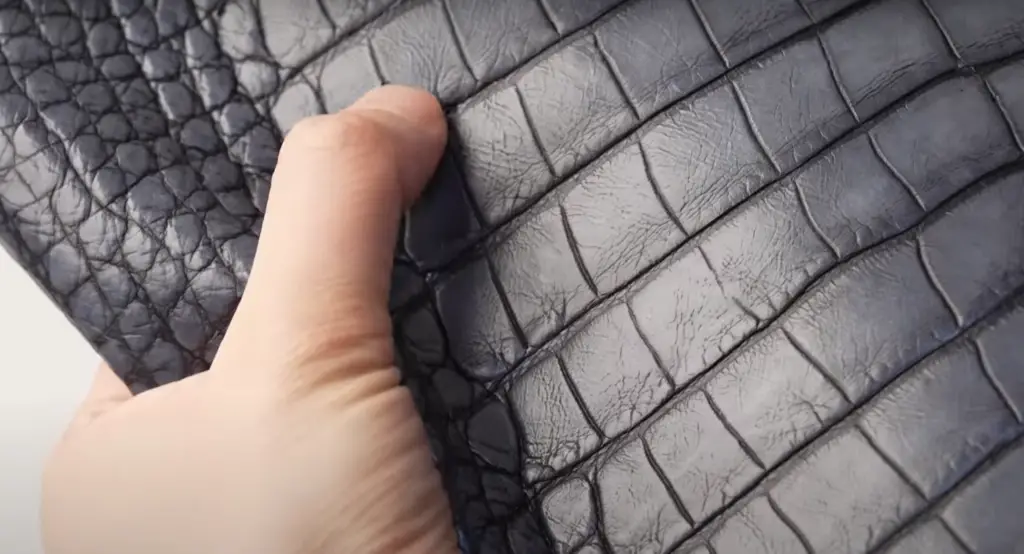
When it comes to price, caiman leather is typically more expensive than alligator or crocodile leather. On average, caiman leather costs about 250 dollars per square foot [2].
Differences between crocodile skin and the alligator skin
Umbilical scar
The scar left behind on an alligator’s skin after it hatches from its egg is usually crescent-shaped. On a crocodile, the scar is more of a figure-eight. This feature is important to look for if you’re trying to identify alligator skin.
Back horns or bumps
Alligators have two large bumps on the back of their heads called “horns.” These horns are not found on crocodiles. Instead, crocodiles have much smaller bumps that run along the length of their backs. The horns on alligators are used for display during mating season and for head-butting contests between male alligators. The bumpy ridge on a crocodile’s back is used to help it swim faster in the water.
Tail shape
One of the most obvious ways to tell an alligator apart from a crocodile is by looking at the tail. Alligators have much wider tails than crocodiles. The width of an alligator’s tail makes up about 50% of its total body width. In contrast, the tail of a crocodile only makes up about 20% of its body width. Alligators use their tails for swimming and for balance when they walk on land. Crocodiles use their tails for swimming and for making abrupt turns in the water to catch their prey.
Teeth
Alligators and crocodiles both have sharp teeth that they use for catching and eating their prey. However, there are some differences in the shape of their teeth. Alligators have shorter and blunter teeth than crocodiles. The teeth of an alligator are more evenly spaced out than the teeth of a crocodile. Crocodiles have longer and sharper teeth that are more closely spaced together. The teeth of both reptiles are used for producing such items as alligator teeth jewelry.
Tile pattern
Alligators and crocodiles both have scaly skin with a rough texture. The scales on the skin of an alligator are called “tiles.” The tiles on an alligator’s skin are larger and more square-shaped than the scales on a crocodile’s skin. The scales on a crocodile’s skin are called “scutes.” The scutes on a crocodile’s skin are smaller and more oval-shaped than the tiles on an alligator’s skin.
Strength of the skin
Alligator skin is much stronger than crocodile skin. Alligator skin is used to make a variety of products, including alligator belts, wallets, and shoes. Crocodile skin is not as strong as alligator skin and is not used as often in the leather industry. However, crocodile skin is still used to make such products as cloth purses and watchbands.
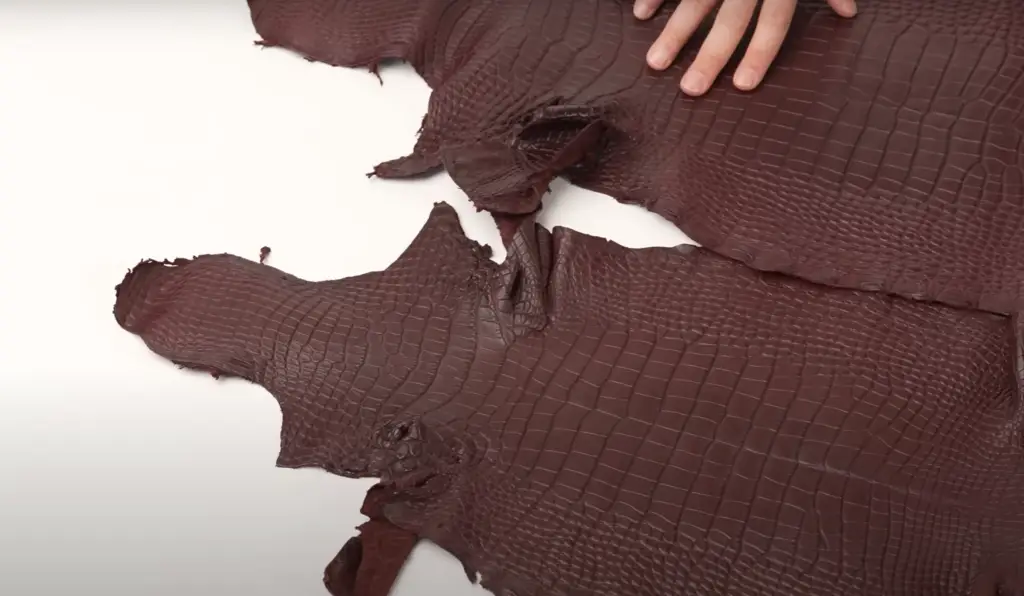
Color of the skin
Alligators and crocodiles both have dark green or black skin. However, alligators tend to have darker skin than crocodiles. Alligators also have white or light-colored bellies, while crocodiles have dark-colored bellies. When it comes to leather products, alligator skin is usually dyed black, while crocodile skin is left its natural color [3].
The difference between crocodile and alligator skin in making leather products
Alligator and crocodile skin are both used to make leather products. But what’s the difference between the two? Here’s a quick guide to help you decide which one is right for you. Crocodile skin is tougher and more durable than alligator skin. It is also less expensive. Alligator skin is softer and more pliable. It is also more expensive.
So, which one should you choose? If you are looking for a leather product that will last a long time and can take a lot of wear and tear, then crocodile skin is the way to go. If you are looking for a leather product that is softer and more comfortable to wear, then alligator skin is the way to go. Of course, price is also a factor to consider. Alligator skin is more expensive than crocodile skin, but it is also more luxurious.
Highlighting the difference between alligator and crocodile leather on a finished product
Finished products of alligator and crocodile leather can look very similar, and sometimes it can be hard to tell them apart. Here are some tips on how to tell the difference:
- Alligator leather usually has a more uniform pattern, while crocodile leather often has a more random, patchy appearance;
- Alligator leather tends to be softer and more pliable than crocodile leather;
- Alligator skin typically has a “pebbly” texture, while crocodile skin often has a smoother surface;
- The scales on alligator leather are usually smaller and more evenly spaced than those on crocodile leather;
If you’re still not sure which is which, ask a professional! They should be able to help you identify the difference.
Here are also the types of products that are usually made of alligator leather and products that are produced from crocodile leather. Alligator leather products:
- Belts;
- Briefcases;
- Wallets;
- Shoes;
- Watchbands;
- Handbags;
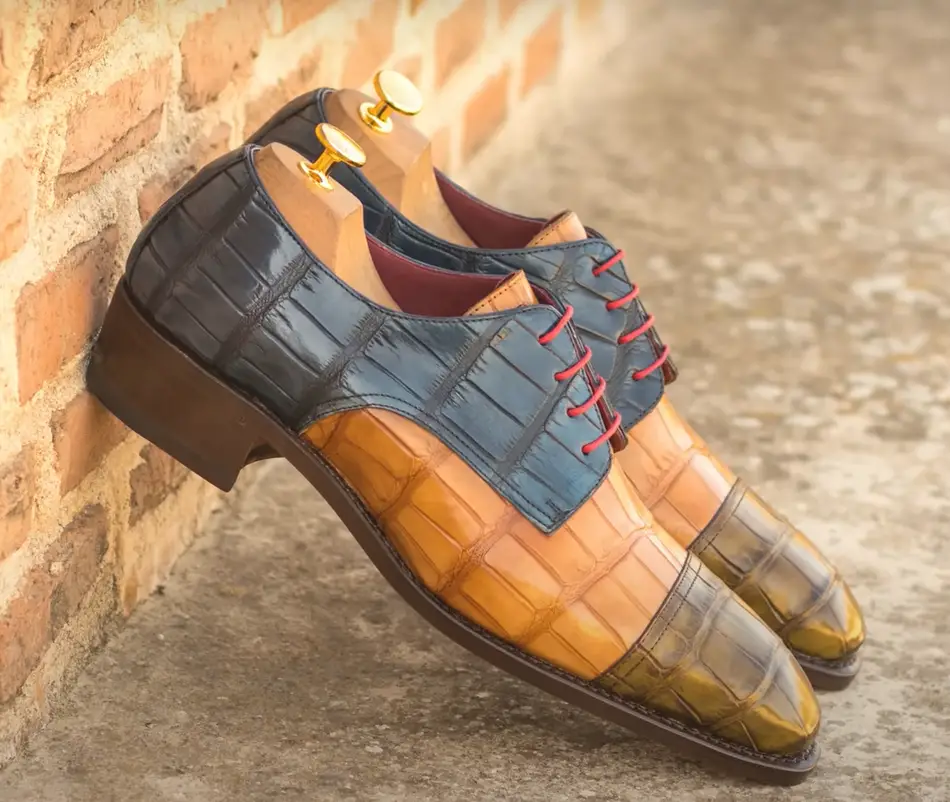
Crocodile leather products:
- Luggage;
- Saddles;
- Harnesses;
- Boots;
- Purses;
So, the next time you’re shopping for a luxurious leather product, pay attention to the details and see if you can tell whether it’s an alligator or crocodile [4]!
What to consider when buying shoes made of crocodile leather?
When buying shoes made of crocodile leather, it is important to consider a few things. The first is the country of origin. Crocodiles are found in many different countries, and each country has its own laws and regulations regarding the hunting and export of crocodiles. It is important to make sure that the shoes you are considering purchasing were made in a country with strict laws and regulations surrounding the hunting and export of crocodiles.
The second thing to consider is the tanning process. Crocodile leather is often treated with chemicals during the tanning process, which can be harmful to your health if you are not careful. Make sure to ask about the tanning process used on the shoes you are considering purchasing, and only buy shoes made of crocodile leather that has been treated in a safe and environmentally friendly manner.
The third thing to consider is the price. Crocodile leather is often more expensive than other types of leather, so it is important to make sure that you are getting a good deal when you purchase crocodile leather shoes. Compare prices from different retailers, and only purchase shoes made of crocodile leather from a reputable retailer.
Don’t forget to consider the color and strength of the shoes. The color of crocodile leather can range from light to dark, and the strength of the shoes will depend on the type of crocodile used to make them. Choose a color and strength that you are comfortable with, and be sure to ask about the different types of crocodiles used to make shoes before making your purchase.
What to consider when buying a handbag made of alligator leather?
When buying a handbag made of alligator leather, it is important to consider the following factors:
- The source of the alligator leather: Alligator leather can be sourced from either farmed alligators or wild-caught alligators. Farm-raised alligators are typically raised in controlled environments and are not exposed to the same stresses as wild-caught alligators. As a result, farm-raised alligators usually have fewer scars and markings on their skin, which results in higher-quality alligator leather;
- The tanning process: Alligator leather is typically tanned using either chrome or vegetable tanning methods. Chrome tanning is the most common method used and results in a soft, pliable hide. Vegetable tanning is a more traditional method that uses plant-based materials to tan alligator leather. This method results in a stronger, more durable hide;
- The grade of alligator leather: Alligator leather is graded on a scale from A to C, with A being the highest quality. Grade A alligator leather is typically free of scars and markings and has a consistent texture. Grade B alligator leather may have some scars and markings but still has a consistent texture. Grade C alligator leather will have more scars and markings and an inconsistent texture;
FAQ
Is alligator or crocodile leather better?
The two types of leather are very similar, but alligator leather is generally considered to be of a higher quality. Alligator skin is tougher and more durable than crocodile skin, making it better suited for use in high-end products such as shoes, belts, and wallets.
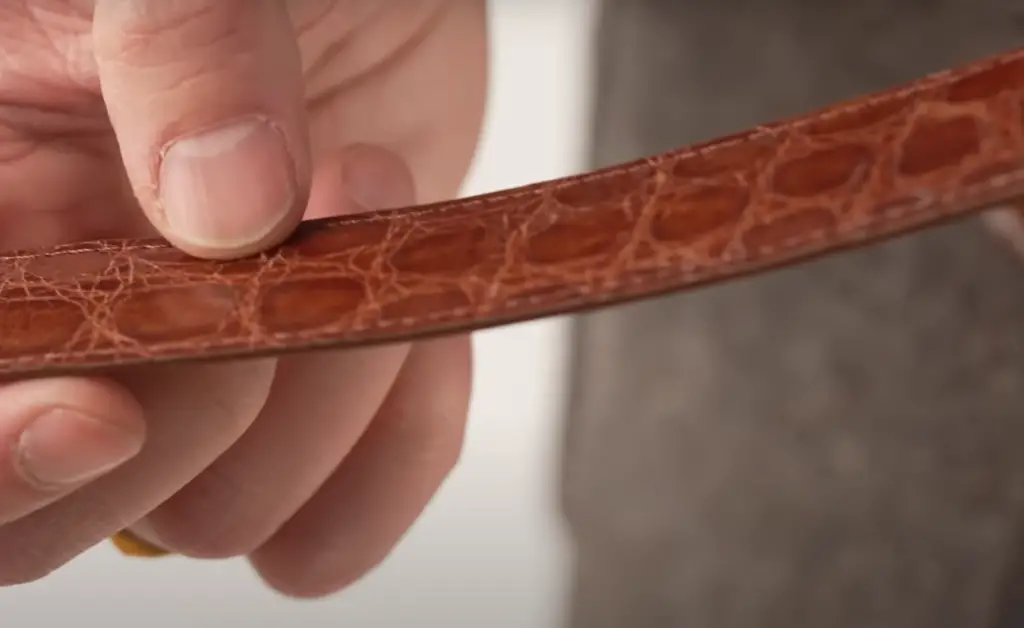
What’s the difference between alligator and crocodile leather?
Alligator and crocodile skin both have a rough, scaly texture. However, alligator skin is tougher and more flexible than crocodile skin. Additionally, alligator leather has a more consistent pattern than crocodile leather, which can often be blotchy or uneven.
Where does alligator leather come from?
Alligator skins are typically sourced from farms in the southern United States, where the animals are raised for their meat and leather. Crocodile skins are typically sourced from farms in Africa and Australia.
What is the most luxurious leather?
There is no definitive answer, as what constitutes “luxury” is subjective. However, alligator and crocodile skin are both considered to be luxurious materials, as they are both rare and expensive.
Is alligator skin bulletproof?
No, alligator skin is not bulletproof. However, it is very tough and durable, making it an ideal material for use in high-end products such as shoes, belts, and wallets. Alligator skin is also resistant to tearing and abrasion, making it ideal for use in applications where durability is important.
What products are made from alligator and crocodile leather?
Both alligator and crocodile leather are used in a variety of high-end products, including shoes, belts, wallets, and purses. Additionally, alligator skin is often used to make guitar straps, as it is resistant to tearing and abrasion. Crocodile skin is also used to make a variety of luxury goods, such as watch bands and luggage.
What is better: animal or alligator leather?
There is no definitive answer, as it depends on personal preferences. Some people prefer animal leather because it is more affordable, while others prefer alligator leather because it is more durable and has higher quality. Moreover, the leather pattern also plays a role in the choice as alligator usually has a more consistent texture. Ultimately, the decision of which type of leather to buy depends on the individual’s needs and budget.
Is alligator skin endangered?
No, alligator skin is not an endangered material. Alligators are considered to be a sustainable resource, as they are bred in captivity for their meat and leather. As such, there is no need to harvest wild populations of alligators.
Useful Video: Why Are Crocodile & Alligator Leather Goods So Expensive?
Conclusion
In the end, both alligator and crocodile leather is unique, luxurious materials that have a lot to offer. It comes down to a matter of personal preference when deciding which one is right for you. If you’re looking for a more traditional look, then alligator leather might be the way to go. But if you want something with a little more attitude, then crocodile leather is the material for you. Whichever one you choose, you can be sure that you’ll be making a fashion statement that will turn heads.
References:
- https://www.gentlemansgazette.com/crocodile-alligator-leather-goods/
- https://www.crocodile-bag.com/what-is-the-difference-between-crocodile-skin-and-alligator-skin.html
- https://acadianleathers.com/2019/02/identifying-the-difference-between-alligator-and-crocodile-leather/
- https://drwatchstrap.com/about-us/crocodile-vs-alligator-leather-vs-calf-leather-croco-embossed-difference/


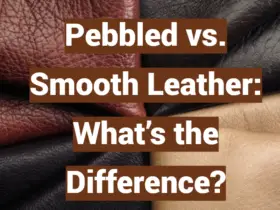

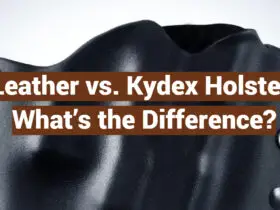


Leave a Reply